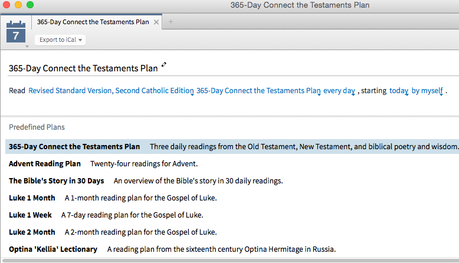In this issue that kicks off a new year, we present ESSAYS and POSTS about how you can easily read the entire Bible in 12 months, the mysterious Magi who visited the Christ child , Pope Francis' plan to name new Cardinals and will our Archbishop Chaput be among them, and how the media (again) tried to pit Pope Francis against Pope Benedict.
How to Easily Read the Whole Bible in 2015
by Brandon Vogt
Why not commit to reading the whole Bible in 2015? It's not as hard as you might think. Here is a simple guide explaining how to choose the best translation and reading plan to help you do it.

As you prepare for the new year, why not commit to reading the entire Bible in 2015? It's not as hard as you might think.
The Bible contains somewhere around 775,000 words. The average adult reads 250 words per minute. That means if you read the Bible for just 30 minutes per day, you'll get through the whole thing in a year-three times over! (If you read just 10 minutes a day, you'll still make it through once.)
But once committing to read the whole Bible, people generally have two questions: which translation should I use, and how should I do it?
Regarding translations, there's a few things to keep in mind. First, make sure your Bible is complete. Protestant translations (NIV, ESV, TEV, etc.) do not contain the seven deuterocanonical books that the Catholic Church accepts as Sacred Scripture. You're going to want those books in your Bible (they're really good!).
Second, make sure your Bible translation strikes a good balance between precision and readability. For serious study, avoid paraphrase translations (such as The Message). Instead, go with a more literal (i.e., "word for word") translation that is still easy to read. Here are my personal recommendations, in order. All of them have been officially approved by the Church for personal study:
Revised Standard Version - 2nd Catholic Edition (RSV-2CE) - The top choice for many Catholic Bible scholars. It's a Church-approved translation and is literal but still very readable.
New American Bible - Revised Edition (NAB-RE) - This is the translation used during the Mass, although it does contain some questionably translated passages and some even worse footnotes. But if you want to sync your reading to the liturgy, this is your best choice.
New Revised Standard Version (NRSV) - Solid translation although it contains "gender inclusive language", changing "brothers" to "friends" or "brothers and sisters" and removing instances of the divine "He".
Douay-Rheims Version (DR) - This was the standard Bible for English-speaking Catholics from 1609 until the twentieth century. It's a trusted version but some readers find it turgid, similar to the King James Version.
There are also Bibles on the market that are specifically designed for a one-year reading plan. For instance, there's the My Daily Catholic Bible (NAB) which divides all of Scripture into 365 segments, one for each day of the year. It features two small, manageable readings for each day, one from the Old Testament and one from the New Testament, along with an insightful quote from a saint for every day. The best part is that the readings are all grouped together sequentially so you don't have to flip back and forth each day between the Old and New Testaments.
There's also the Catholic One Year Bible which uses the Catholic Living Bible translation, a less-then-literal translation but one that many readers find looser and more accessible.
In the end, what matters most is that you find a translation you'll actually read. If you pick one that is cumbersome or inaccessible, then it doesn't really matter whether it's accurate. Your best bet is to sample a few translations online and then choose one you feel most comfortable reading each day.
What's the Best Plan?Similar to the translation question, the answer here is whichever plan you'll follow. Unfortunately, many people make the mistake of starting with Genesis and trying to plow straight through to Revelation, linearly. The problem is that some of the early Old Testament books are meticulous, such as Leviticus and Numbers, and most people get bogged down, wiping out before finishing even half the Old Testament.
What's a better strategy? To follow a carefully designed reading plan that will take you through the right books, at the right pace. Some of these plans alternate between Old and New Testament readings, while some intersperse the Psalms throughout the year to add variation.
Here are some of my favorite Bible reading plans for Catholics. Choose your Bible, then choose one of the plans below and make 2015 the year you finally finish the whole Bible:
Read the Bible and the Catechism in a Year - This plan, created by the Coming Home Network, is definitely my favorite. Not only does it take you through the whole Bible (the Catholic Bible, including the deutero-canonical books), but it also gets you through the entire Catechism of the Catholic Church. Each day you read about three chapters of Scripture and fifteen paragraphs of the Catechism. You'll knock out both assignments in about thirty minutes each day.
Dr. Mary Healy's Read the Bible in a Year Plan - This plan by Dr. Mary Healy, a renowned Catholic biblical scholar, is great because it has you reading excerpts from the Old Testament, Psalms, and New Testament each day. That means when you get to the difficult Old Testament sections, you'll still have the Psalms and New Testament to balance out your daily reading.
CatholicBibleInAYear.org Reading Plan - This one is similar to Dr. Healy's plan except it gives you even more variety each day. You'll read two Old Testament readings, one New Testament reading, and one psalm each day.
My Personal SolutionI mentioned above that I prefer the Revised Standard Version - 2nd Catholic Edition (RSV-2CE) for Scripture study. But I also have a secret weapon: the Verbum Bible software.
I've written before about how amazing this is, calling it the most powerful Bible resource ever available. But it also makes it super easy to read the Bible in a year. The new Verbum comes with a built-in plan, right out of the box:

The best part about using Verbum is that the reading plan syncs across all of your devices. So you can read your daily passages on your computer, tablet, phone, or any other mobile device. It's great for people like me who are constantly on the go and often forget to carry around a paperback Bible. Verbum also syncs your highlights and notes across all devices, so the reading experience is seamless.
The Verbum software can be pretty expensive-the base packages each cost hundreds of dollars-but the cheapest way to get access to the software is by purchasing the Catechism of the Catholic Church Collection. It's only $49.95 and gives you lifetime access to the powerful Verbum software (the most important resource), along with the Revised Standard Version - Catholic Edition (RSV-CE), the lectionary (the readings used at Mass), the documents of Vatican II and the Council of Trent, and a few other resources. All of those documents can be accessed on the go, on any device you're using. In my opinion, the cost of this is software is more than worth it if it enables you to finish the Bible in a year.
Disclosure of Material Connection: Some of the links in the post above are "affiliate links." This means if you click on the link and purchase the item, I will receive an affiliate commission. Regardless, I only recommend products or services I use personally and believe will add value to my readers. I am disclosing this in accordance with the Federal Trade Commission's 16 CFR, Part 255: "Guides Concerning the Use of Endorsements and Testimonials in Advertising."

